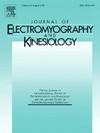Shoulder muscle activity magnitude and timing in individuals with specific scapular movement patterns
IF 2.3
4区 医学
Q3 NEUROSCIENCES
引用次数: 0
Abstract
Relationships between specific muscle activity alterations and specific scapular motion patterns have not been well established. The purpose of this study was to identify muscle activation magnitude and timing in two specific scapular movement groups (excessive scapular anterior tilt, scapular lateralization). Surface electromyography (EMG) was captured simultaneously with biplane video radiography and optical motion capture during two repetitions each of shoulder flexion, abduction, and unrestricted overhead reaching in 45 adults with shoulder pain. The following muscle activation magnitudes measured with EMG were assessed individually and in ratios: lower trapezius (LT), serratus anterior (SA), upper trapezius (UT), anterior deltoid (AD), and middle deltoid (MD). The timing of each muscle’s initiation was calculated as a percent of humerothoracic range of motion. For EMG magnitude, significant interactions including group were found for AD, LT/SA, and LT/AD. Findings suggest a relative reduction of SA in both groups in the constrained motions compared to the self-selected motion and a reduction in LT in the lateralization group in early motion. For EMG timing, no group effects were significant, however findings suggest delays in SA and LT activation in both groups. The findings provide evidence that individuals with different scapular movement patterns may have distinct muscle activity patterns which can inform patient-specific rehabilitation interventions.
特定肩胛骨运动模式个体的肩部肌肉活动幅度和时间
特定肌肉活动改变与特定肩胛骨运动模式之间的关系尚未得到很好的确立。本研究的目的是确定两种特定肩胛骨运动组(肩胛骨过度前倾和肩胛骨偏侧)的肌肉激活程度和时间。对45例肩关节疼痛的成年人进行两次重复的肩部屈曲、外展和不受限制的头顶伸展运动,同时用双翼视频x线摄影和光学运动捕捉捕捉体表肌电图(EMG)。以下肌电图测量的肌肉激活幅度分别按比例进行评估:下斜方肌(LT)、前锯肌(SA)、上斜方肌(UT)、前三角肌(AD)和中三角肌(MD)。每块肌肉开始运动的时间是用胸骨活动度的百分比来计算的。对于肌电图,AD、LT/SA和LT/AD的显著相互作用包括组。研究结果表明,与自我选择运动相比,两组在受限运动中SA相对减少,而侧化组在早期运动中LT减少。对于肌电时间,没有明显的组效应,但研究结果表明两组的SA和LT激活延迟。研究结果表明,不同肩胛骨运动模式的个体可能有不同的肌肉活动模式,这可以为患者特定的康复干预提供信息。
本文章由计算机程序翻译,如有差异,请以英文原文为准。
求助全文
约1分钟内获得全文
求助全文
来源期刊
CiteScore
4.70
自引率
8.00%
发文量
70
审稿时长
74 days
期刊介绍:
Journal of Electromyography & Kinesiology is the primary source for outstanding original articles on the study of human movement from muscle contraction via its motor units and sensory system to integrated motion through mechanical and electrical detection techniques.
As the official publication of the International Society of Electrophysiology and Kinesiology, the journal is dedicated to publishing the best work in all areas of electromyography and kinesiology, including: control of movement, muscle fatigue, muscle and nerve properties, joint biomechanics and electrical stimulation. Applications in rehabilitation, sports & exercise, motion analysis, ergonomics, alternative & complimentary medicine, measures of human performance and technical articles on electromyographic signal processing are welcome.

 求助内容:
求助内容: 应助结果提醒方式:
应助结果提醒方式:


